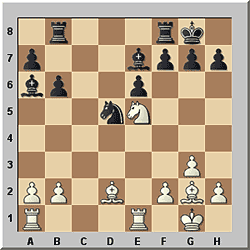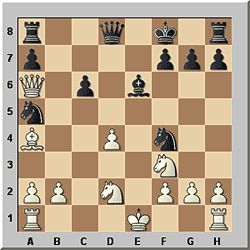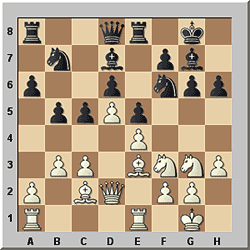A genial genius at work
The following video was pointed out to us by Mark Hanon, Oxford, England, and
was studied by our Russian-speaking associate Steve Giddins, who prepared the
following synopsis.
Addendum: Valery Adzhiev of Bournemouth, UK,
informs us that the video is a fragment from the documentary "Seven steps
beyond the horizon" about the limits of brainpower (director: Felix Sobolev).
It was made in 1968 and released in 1969.
The commentary is all in Russian and unfortunately, does not reveal the date
of the performance. Initially, one sees the announcer going from board to board,
announcing the board number and the move played. Tal usually replies almost
immediately, but at one point, he replies "Just a moment", and thinks
for a minute or so, before moving. The commentary then clicks, in, with an interviewer
posing questions, and Tal replying. He is asked whether he has been doing such
blindfold displays very long, and Tal replies that this is his first such display.
"Well, actually, not strictly the first," he then adds. He explains
that he once gave one whilst in hospital, recovering from an operation! It seems
that in this display he won three games, and would probably have lost the fourth,
had his opponent not been taken off to the operating theatre at the crucial
moment! The present display, though, is Tal's first public exhibition of blindfold
simultaneous play.
Tal mentions that Alekhine gave such a simul over 30 boards, and that "there
is also in Hungary a young master called Janos Flesch, who has done a
simul on 54 boards". Tal admits that he cannot imagine doing a display
over such a number. When asked how he can play such blindfold games, and whether
he sees the pieces exactly in his mind, he replies in the negative, and adds
that it is impossible to explain how one's mind works in such situations.
Sadly, one cannot see the boards, nor are the full scores of any of the games
given. However, at a certain point in the display, Tal recounts the moves so
far, of four of the most interesting games. This section occurs between 3.55
and 6.40 minutes, and even those who do not speak Russian will get some impression
of how fast Tal is able to recite the moves, purely from memory. These are the
fragments of the four games:
Tal - N:N [D06] Board six
1.d4 d5 2.c4 Nf6 3.cxd5 Nxd5 4.Nf3 Bg4 5.Qb3 Nb6 6.Nbd2 e6 7.g3 Nc6 8.Bg2
Be7 9.0-0 0-0 10.Rd1 Nxd4 "A perfectly correct decision"
11.Nxd4
Qxd4 12.Bxb7 Bxe2 13.Re1 Rab8 "This move I had failed to notice in
advance".
14.Bg2 Ba6 "Here, I thought 14...Nd5 or 14...Nc4
were more dangerous".
15.Nf3 Qb4 16.Bf4 Nd5 17.Bd2 Qb6 18.Qxb6 cxb6
19.Ne5
Tal - N.N. [C54] Board seven
1.e4 e5 2.Nf3 Nc6 3.Bc4 Bc5 4.c3 Nf6 5.d4 exd4 6.cxd4 Bb4+ 7.Bd2 Bxd2+ 8.Nbxd2
d5 9.exd5 Nxd5 10.Qb3 Be6 "This move I have never come across before,
but it seems to me to be very interesting".
11.Qxb7 Na5 12.Bb5+ Kf8
13.Qa6 c6 14.Ba4 Nf4 "A very interesting move!"
15.0-0-0
"Unfortunately 15.0-0?? is not possible because of 15...Bc8"
Tal - N.N. [E91] Board eight
1.d4 Nf6 2.c4 g6 3.Nc3 Bg7 4.e4 d6 5.Nf3 0–0 6.Be2 Nbd7 "Here
I sacrificed a pawn".
7.e5 dxe5 8.dxe5 Ng4 9.e6 fxe6 10.0–0 Nde5 11.Qc2
Nxf3+ 12.Bxf3 Ne5 13.Be2 Qe8 14.Be3 Nc6 15.Rad1
Tal - N.N [C93] Board nine
1.e4 e5 2.Nf3 Nc6 3.Bb5 a6 4.Ba4 Nf6 5.0–0 b5 6.Bb3 Be7 7.d4 d6 8.c3
0–0 9.h3 h6 10.Re1 Re8 11.Nbd2 Bf8 12.Nf1 Bd7 13.Ng3 Na5 14.Bc2 g6 15.b3 c5
16.d5 Nb7 17.Be3 Bg7 18.Qd2
Shortly afterwards, we see the opponent on board eight offer a draw. Tal takes
a long puff of his cigarette, announces "I will think about it", and
then thinks for a minute or so, before announcing his wish to play on, and indicating
his move. At 7.26, Tal is informed that his opponent on board three has played
Ke8-f8. Immediately, he replies "I think Black has made a mistake. I can
play b4xc5. Maybe Black would like to choose another move instead?" His
grateful young adversary takes his advice!
In the final few minutes, we see various games ending. On board 10, Tal is
offered a draw, and accepts, adding with a smile "I thank my opponent for
his generosity. He helped me to save this game". Board seven also offers
a draw, which is accepted. Board three resigns, and then Tal offers a draw on
board six, which is accepted. The announcer declares the final result of the
display: 7:3 in favour of the grandmaster, with four wins and six draws.
In conclusion, declares the narrator, the display is a remarkable demonstration
of the potentialities of the human mind. As a chess fan, I can only add that
the video itself is a delight, a unique chance to see one of the great figures
of chess history demonstrating his remarkable talent. If any readers out there
know where any of the game scores from this simultaneous can be found, we should
be most interested from hear from them.
Source


























